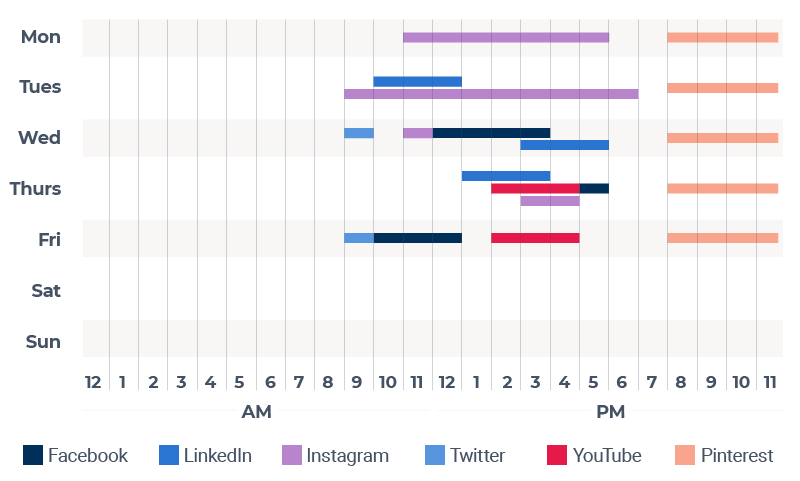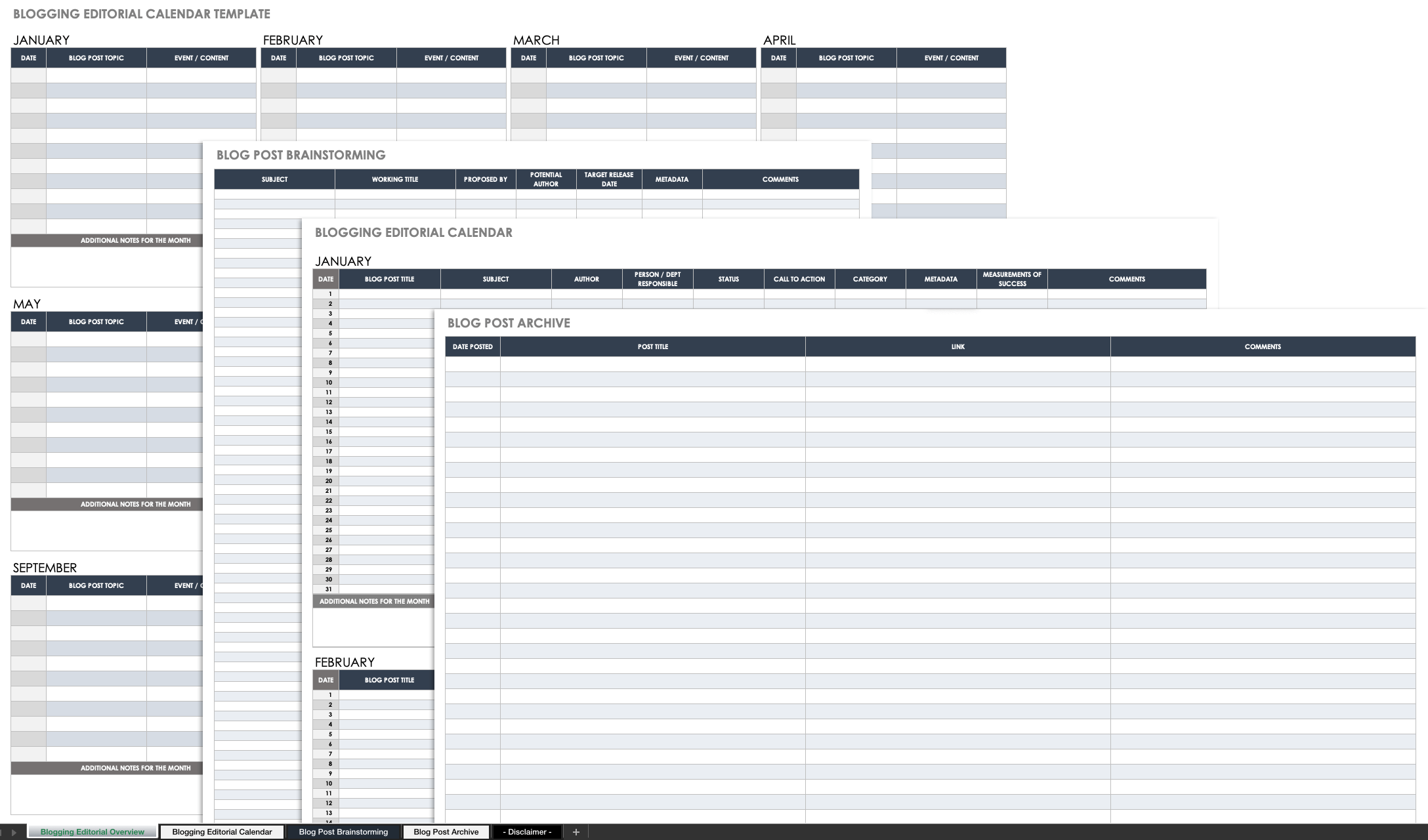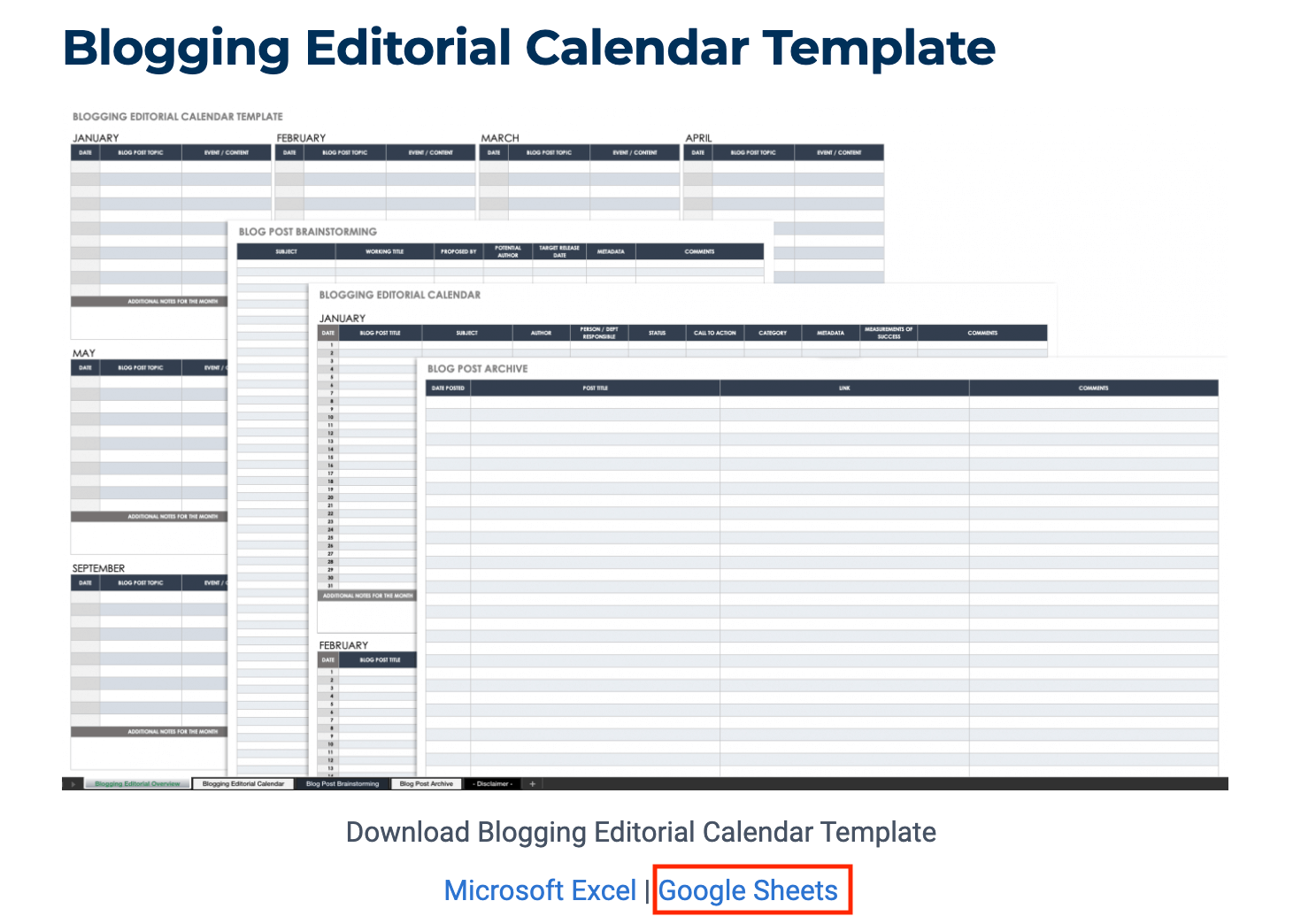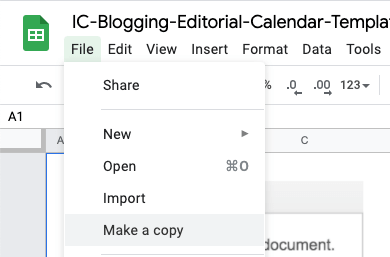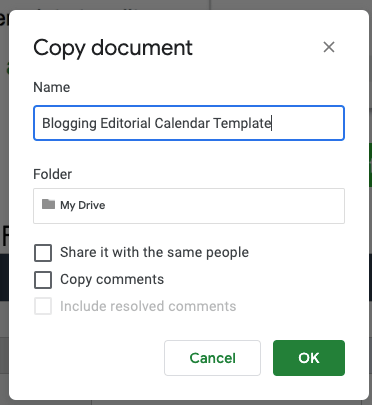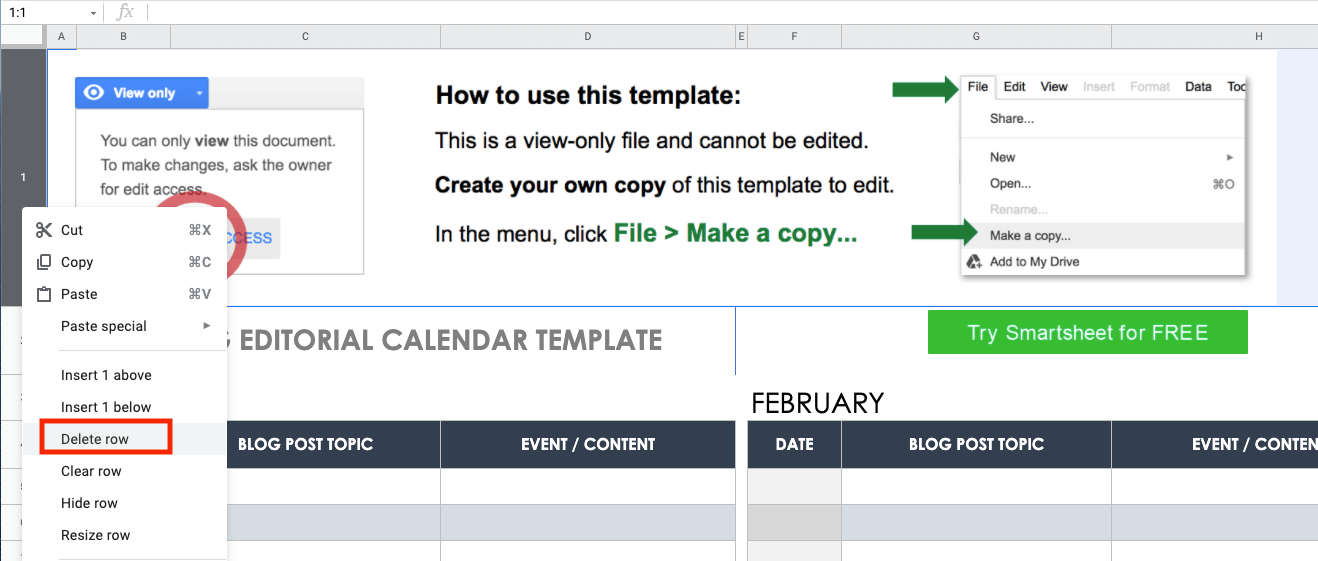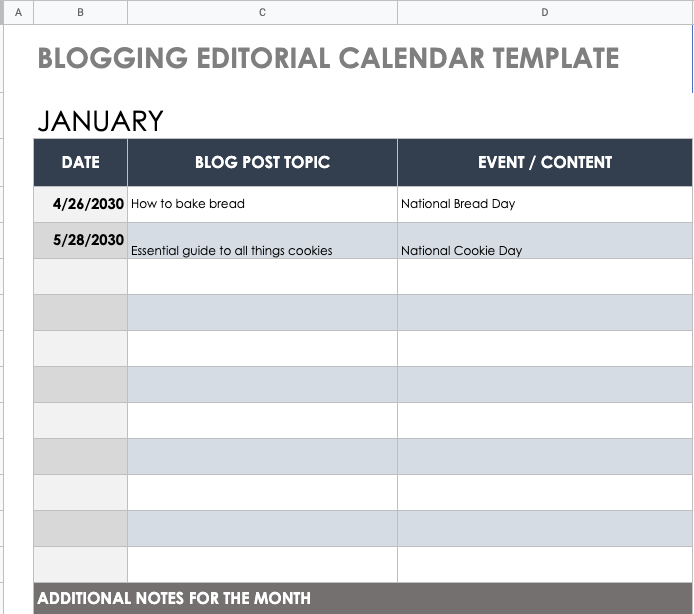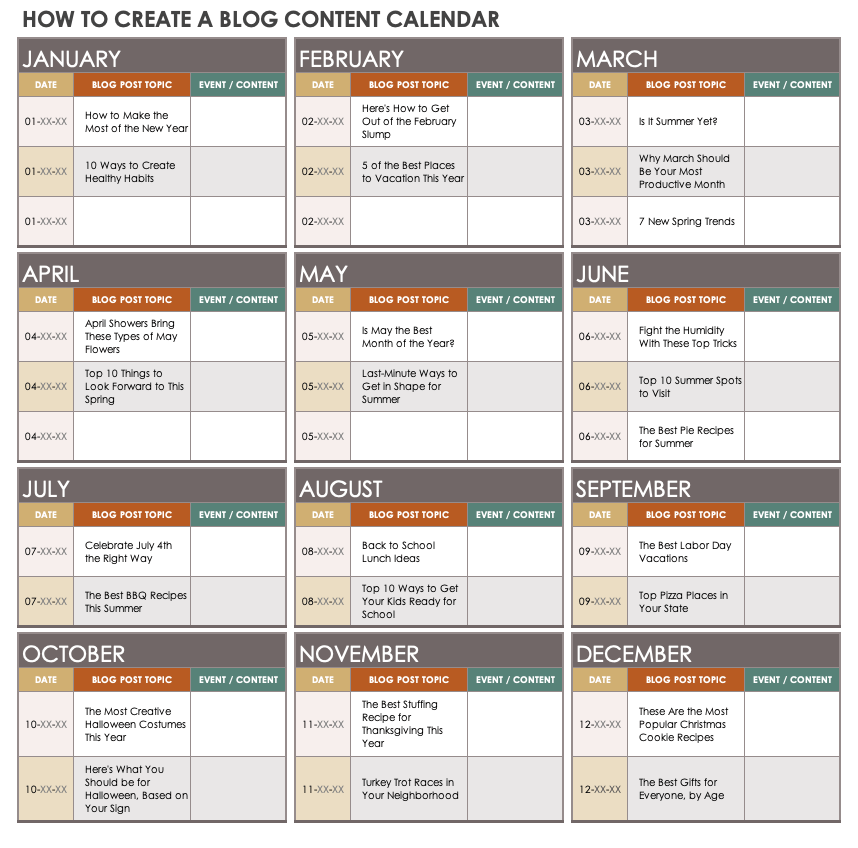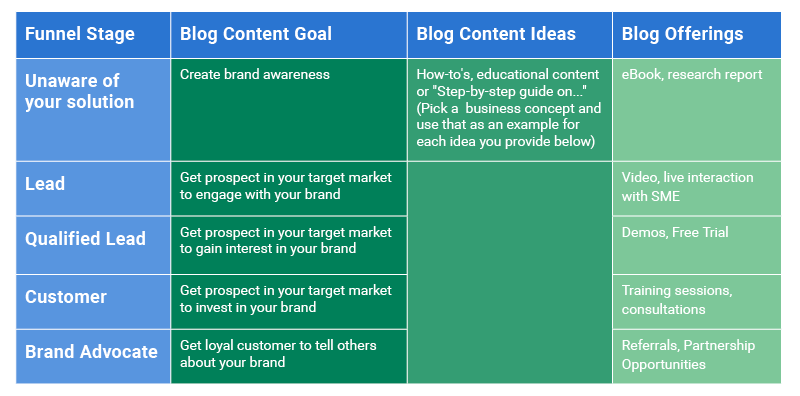What Is a Blog Editorial Calendar?
A blog editorial calendar, also called a blog content calendar, is an editable document that outlines the content you plan to publish on certain days. You can organize the calendar by week, month, or year.
A blog editorial calendar comes in many formats, including a printable hard copy, a spreadsheet, or even via an app.
Though similar, a blog editorial and content calendar is separate from a social media calendar, which focuses on the content published on different social media platforms, such as Facebook, LinkedIn, Twitter, Instagram, and others.
How to Create a Content Calendar for a Blog
To create an effective content calendar for your blog, follow these simple steps:
- Identify your content channels. It’s important that you know and understand your content channels and the types of content to leverage within each channel. Although your blog content calendar will only focus on the specific blogging content that you produce, here are some additional popular channels and the types of content that fits within each:
- A Blog or Regularly Updated Website: Here, you’ll usually find informational articles around thought leadership, product launches, company announcements, and new event details.
- Social Media Platforms (Facebook, LinkedIn, Twitter, Instagram, etc.): Use these channels for quick snippets of content, such as remarketing, advertisements, and important announcements.
- Email: Email is best for longer-form communication, such as email nurture programs, newsletters, and in-depth product updates.
- Video: You can leverage video content for webinars, demo videos, on-demand instructional videos, and more.
- Podcasts: A newer channel for content, podcasts offer a way to create even more thought leadership around a topic or to feature experts or C-suite executives to weigh in on specific topics.
- Print Magazines, Brochures, or Newsletters: Use this channel to distribute physical content, such as company brochures or newsletters about upcoming events and product launches.
- Other Marketing Content and Materials: This encompasses all other types of marketing content, such as paid advertising.
- Pick a calendar format that makes sense for you. Determine how far in advance you want to plan out your content and how in-depth you want each day, week, or month to be. That way, you can better leverage either daily, weekly, or monthly blog content calendars and track your content in a way that works for you.
- Create a calendar using a blog calendar software or tool, or use a template. To get started quickly, leverage a specific blog calendar tool that is designed to help you plan, manage, and track your content with ease. Alternatively, you can use a template that already has the blog content framework, so you simply need to add your blog content to get started.
- Brainstorm content ideas on a regular basis.
Kris Hughes, Founder of Zanate Ventures, offers the following advice regarding how and when to brainstorm content: “I like to plan a month ahead of time. I refer back to my cause and the pillars of trust, value, and demand when writing for my own blog. I review the topics I've already thought through in the past to see if those have been covered. Then, I like to set a timer and get in the zone for an hour or two of just brainstorming topics. I take a blank document and just write ideas down. No self-judgment. Then, I take the time to go back through them afterward and narrow down to those I want to do some SEO research on and that would fill gaps based on what I've published previously.”
Melissa Harrison, CEO at Allee Creative, a content marketing agency, says that they brainstorm new content ideas monthly. She goes on to say that, “We use a combination of Google Analytics, top performing posts, keywords we want to be found for, frequent questions or topics our clients ask about, etc. [...] Then, we use our established content categories to ensure we’re keeping true to the type of content/posts we want to write and alternate through them so that we don’t publish posts unevenly in particular topics.” - Do keyword research. As you plan your blog content, keep in mind the specific keywords and intents that are likely to convert readers into customers, and use that research to inform your blog posts. Hitesh Sahni is a content strategy consultant, and the Editor and Founder of Smemark, an upscale content marketing studio that helps brands and agencies in multiple niches accelerate growth with superior, scalable content. “Our go-to strategies for content ideas are keyword research and interviewing customers or customer-facing staff,” he says. “Both of these help us get an accurate assessment of the most pressing issues we should address with our content. Frequency of such brainstorming sessions depends on how many ideas we get in each session.”
- Document all content ideas. As you brainstorm new content ideas and strategize about which ones make the most sense to write, jot down all ideas, either using a pen and paper or a note-taking tool.
- Consider the types of content you plan to produce. Ask yourself who you will target with buyer personas, and which specific value propositions (of your product or service) you want to deliver to your reader. Also consider which stage — whether top, middle, or bottom funnel of a customer journey — your readers are at in order to determine the most appropriate content to create.
- Schedule topics and posts in the calendar. Document when you want to publish your content and identify the optimal publishing times for different content channels.As Kris Hughes notes, “What matters most is consistency and determining what that consistency means to you. For someone who's starting out and doesn't yet have a heavy client workload, it may be a few posts a week. For someone who's juggling several clients, it may be one per week on a personal project and one per week for a client. It's not an easy question to answer without context. It's truly a personal situation. But what matters most is to set a goal you can reach with consistency to build momentum for yourself or satisfy the expectations of your clients.”
- Color-code your content types. For an easy, at-a-glance look at the different audiences that your content is targeting, choose specific colors for each audience, and note that in a legend within your calendar.
- Add content themes and important business dates. Within your calendar, make sure you note any wide-ranging content themes or key dates, such as holidays, peak business seasons, and key industry dates, including product launches, webinars, or in-person events.
- Designate one person who is in charge of the calendar. Typically, this person is the owner of the blog and has a content-related background. This person is also responsible for delegating tasks, including the following:
- Who will manage the calendar?
- Who will have access to the calendar?
- What will be included in the calendar?
- How often will the calendar be updated?
- Stick to your schedule. Schedule when posts will go live using a content management platform, which will help you automatically schedule and post content, alert you when content is past due, and send reminders when scheduled publish dates are approaching.
- Maintain and update the calendar on a regular basis. Hold regular meetings to address any roadblocks or delays, update the calendar as posts go live or are archived, and make sure the designated point person, identified above, is kept in the loop when changes are made to the calendar.
How to Create a Content Calendar for Your Blog Using a Template
Sometimes, the best way to get started with your blog content calendar is to download a simple template. At his organization, Sahni says that his team usually leverages “a simple Google Sheet to create and use content calendars for clients, as well as my own business.”
Download Blogging Editorial Calendar Template — Google Sheets
To get you up and running quickly, download this free blogging editorial calendar template to help you plan and execute on your content. Follow the steps below to set up your calendar in Google Sheets:
Make a Copy of the Template
- Click on the template link to open the template in Google Sheets.
- Make a copy of the template by clicking File from the top navigation bar and selecting Make a Copy.
- Rename your template, select a folder where you would like to house your template, and click OK. Your copied template will open in a new window.
Remove the Top Image
- Next, you’ll want to remove the image at the top of the template. To do so, select the image and click Delete on your keyboard.
- Then, right-click on the first cell and select Delete row. This will remove the now-blank row from your template.
Enter Information on Blog Editorial Overview Tab
- Enter big-picture details like dates, blog post topics, event/content, and additional notes for each month by clicking within the cell and typing in your information.
Enter Information on Blog Editorial Calendar Tab
- Navigate to the Blog Editorial Calendar tab in your sheet by clicking on the appropriate tab at the bottom of your sheet.
- Enter all blog-related details, such as blog post dates, titles, subjects, authors, calls to action (CTA), and more.
Enter Information on Blog Post Brainstorming Tab
- Navigate to the Blog Post Brainstorming tab in your sheet by clicking on the appropriate tab at the bottom of your sheet.
- Within this tab, enter all brainstorming details for each blog post idea, such as blog post subject, potential title, proposed-by details, potential writer, target publish date, and any additional notes.
Enter Information on Blog Post Archive Tab
- Navigate to the Blog Post Archive tab in your sheet by clicking on the appropriate tab at the bottom of your sheet.
- Within this tab, enter any tracking details for your blog posts, publish date, blog post titles, links, and any performance metrics, such as clicks, likes, comments, and shares.
For additional blog content strategy templates like this one, visit our article with a variety of blogging templates for different use cases.
Blog Content Calendar Example
Blog Content Calendar Example
Here you’ll find an example of a blog content calendar with details, such as post title, writer, publish date, CTAs, and more. Use this example as a model for your own blog content calendar so you’re set up for success from the start.
What’s in a Blog Business Content Calendar?
A blog business content calendar contains specific components including blog topics, category of content, call to action, marketing channels, and social messaging.
In addition to these core components, you can include many other things in your blog business content calendar, such as the following:
- Assigned writers
- Content type (SEO, evergreen, promotional, video, audio, etc.)
- Suggested headline
- Due dates
- Titles and topics
- Target keywords
- Word count
- Image(s) and image source
- Additional resources (if applicable)
- Status of content (in progress, written, edited, approved, published)
- Additional assets, such as templates and links to SME websites
- Publish dates
If you’re looking for a template to help you get started, visit this article for a free, downloadable blog business calendar template.
Tips for Creating a Blog Content Calendar
As you create your blog content calendar, follow the following best practices to ensure you’re crafting the most effective way to plan, track, and manage your blog content.
- Define the specific goals of your blog. Ask yourself the following questions: What are my key performance goals? What metrics will I use to assess my content (i.e. traffic, likes, comments, shares, conversions to trial)?
- Schedule a monthly meeting with cross-functional teams. Doing so ensures that you are in the loop on all key company-related goals and can create content based on these important dates and business milestones.
- Add all known dates to your calendar immediately, such as company events, holidays, and product launches. This way, you can write content for these specific dates and events and can plan additional content around them.
- Determine how many blog posts you want to produce. Identify your daily, weekly, and monthly blog goals and determine the cadence with which you want to post new blogs.
- Create or download a blog content calendar template. Doing so will help you get started faster by providing a framework for your calendar that you can fill in with your blog content, publishing dates, writers, and other key details.
- Determine any existing content you can repurpose. You may already have existing content that you can update to fit the needs of your blog, which will save you time and resources by not having to create brand-new content. Complete a quick content audit to see what you already have and how you can repurpose the content that already exists.
Sahni offers a reminder: “Implementation and execution are more important in the beginning than having a fancy calendar. First make sure you have the budget, people, and resources to create content according to the schedule you set forth in your content calendar.”
When asked his main tips for people trying to create or maintain a blog content calendar, Hughes says, “Everyone's methods are different. Some people are old school and may prefer to use paper calendars, planners, or color-coded notebooks. Others will use cloud-based calendars to schedule everything out and stay on track. Do what works for you. Don't try to force the square peg into a round hole. Stick with whatever's easy for you to adopt, and stick with it over time, because consistently using a calendar is the best way to make it an impactful part of your workflow.”
Benefits of a Blog Content Calendar
A blog content calendar can help you be more organized and productive when it comes to brainstorming, writing, editing, and publishing blog posts. Additionally, the benefits of a blog content calendar include the following:
- Creates a central source of truth for all blog-related details and content plans, such as post ideas and publish dates, which you can then share with a greater, cross-functional team for better insight into your direction
- Shows what you’re writing about at a quick, high-level glance
- Helps you stay consistent regarding how often you post and what you post about
- Keeps you organized by laying out a content plan over a specific period of time
- Holds you and your team accountable for pre-determined deadlines and assigned posts, which can help you hit your deadlines more easily
- Ensures that everyone is on the same page regarding the status of each piece of content you generate
- Maintains alignment between your content strategy and the company’s overall business strategy or marketing goals
- Helps you audit the content you already have and identify any gaps so you can optimize your strategy
Hughes chimes in on the importance of a blog content calendar at his company: “I use blog content calendars to keep myself organized and think about time blocking. I'm an aggressive time blocker, so having a calendar within easy access helps me plan for the work I need to get done each day to meet my submission deadlines — and where I can take days away from writing to work on other non-content projects. It's an essential part of the tool stack for anyone who's serious about freelancing or content marketing.”
How Using a Content Calendar Can Help You Build Your Blog
A content calendar helps you better organize and plan your content so you can see what’s in the writing pipeline at a glance. The calendar allows you to hone in on a content marketing strategy and think strategically about new blog posts.
Additionally, a content calendar can help you do the following:
- Maintain Consistency: By helping you plan out your content in advance and determine your blog post cadence, you can post consistent, well-thought-out content. Sahni says that at his organization, “We consider how much effort each piece of content would require, how much content the competitors are churning out, and how many content creators and editors we can allocate for the project. Based on this information, we decide on a reasonable schedule.”
- Meet Deadlines: Everyone has a view into the publishing schedule and knows what’s expected of them in order to hit publishing dates.
- See What Everyone Else on the Team Is Working On: The calendar gives everyone a clear view into who is assigned to what article.
- Realize ROI: You have a clear view of what content you’re producing and on what cadence, which enables you to trace back your ROI by looking at key metrics, such as conversion from blog posts or traffic to your website.
- Create a Seamless Process to Manage Your Calendar and Upcoming Posts: You can easily achieve this by using a content management tool that allows you to plan, track, and manage your content; alert you of upcoming deadlines; and notify assigned writers when new content is added to the calendar.
Sahni, who uses blog content calendars regularly, says, “I personally use a content calendar as a plan for content to be published in the coming months, as well as an inventory of content we have published so far.”
Blog Calendar Tools
Many tools on the market today can help you build a calendar that maps out your blog content. Some people prefer using older methods, like a spreadsheet, while others rely on a more comprehensive tool, like a calendar or project management app.
We asked experts and rounded up the most common tools that content writers and project managers use to help them manage their blog content, as well as the pros and cons of each tool.
| Tool | Tool Description | Pros | Cons |
|---|---|---|---|
| Google Sheets: | An online spreadsheet tool that enables you to share and collaborate on content with an unlimited number of team members |
|
|
| CoSchedule: | A work management tool for marketers that helps you view, schedule, and share your marketing calendar with others |
|
|
| HubSpot: | A customer relationship management tool that helps you manage your marketing, sales, and customer service content on one platform |
|
|
| Notion: | An all-in-one workspace that helps you do everything from track your content and organize your notes to plan your projects and see product launches through to the end |
|
|
| WordPress: | A content publishing tool that gives you a high-level overview of your content calendar and enables you to edit and move content right within the tool |
|
|
| GatherContent: | A content operations platform that helps you organize your content in less time and at scale with powerful collaboration and sharing features |
|
|
Hughes, who uses the tool Notion to manage his content, says, “I think you can do everything that needs to be done with a tool like Notion and a solid project management tool with Kanban functionality like Smartsheet. There's no reason to break the bank on an expensive tool unless that's something you want to do. Keep it simple and cheap.”
Questions to Ask Before Picking a Blog Calendar Tool
As you consider which tool to implement to help you better manage your content, ask yourself the following questions:
- Does the tool support multiple editors and viewers?
- Does it work on different types of computers (Mac or PC)?
- Who is able to manage and grant permissions?
- Does it include general support?
- Does it include all of the necessary features, like a calendar view and workflow automation?
B2B vs. B2C Content Strategy
While both B2B and B2C content strategies are similar, understanding how to deliver value to each audience is crucial to getting the engagement and financial returns you seek. Here are the main differences between the two content strategies:
Anat Baron, longtime marketing expert and marketing keynote speaker, weighs in on the differences between B2B and B2C blogging.
Business Goals
- B2B: The ultimate business goal for most B2B content strategies is to drive ROI by measuring the tangible data that comes from a content campaign, like conversion rate and number of paying customers.
- B2C: Usually with B2C content strategy, the focus is on creating or building brand awareness and developing two-way customer engagement, rather than strictly ROI. B2C businesses want to find and engage their customers, target their needs and wants, and develop ongoing relationships.
Target Audience
- B2B: The target audience for most B2B content strategies are those business customers that could benefit from using or buying the business’s product or service. These are not general consumers, so they are easier to target. You can identify them as potential customers and deliver content to the specific platforms they frequent.
- B2C: The target audience for most B2C content strategies can vary widely, which means that a B2C company might be trying to target many different personas with different types of content on different types of platforms or channels. B2C content strategy should differentiate among and target specific types of content at existing customers, potential customers, and lapsed customers.
Here’s a helpful visual that can help you determine what kind of content to create for audiences at different stages of the sales funnel.
Download Audiences at Different Stages of the Sales Funnel - PDF
Customer Relationships and Loyalty
- B2B: The right content strategy can lead to the development of personal connections between a B2B organization and its prospective customers. Since the objective is to drive long-term business, the content strategy should be used as a way to put potential customers in touch with the company’s sales team.
- B2C: In the past, B2C companies usually involved a transactional relationship, but today’s consumer-facing brands are increasingly interested in forging relationships with their customers. They want to engage with customers (mostly through social media) who can be advocates and influencers and help spread both their content and brand message. The future will see more focus on creating opportunities for two-way engagement through existing and new platforms. Today’s innovative platforms, like TikTok and Clubhouse, will likely usher in new channels for reaching an audience.
Get the Most Out of Your Blog Content Calendar with Smartsheet
Empower your people to go above and beyond with a flexible platform designed to match the needs of your team — and adapt as those needs change.
The Smartsheet platform makes it easy to plan, capture, manage, and report on work from anywhere, helping your team be more effective and get more done. Report on key metrics and get real-time visibility into work as it happens with roll-up reports, dashboards, and automated workflows built to keep your team connected and informed.
When teams have clarity into the work getting done, there’s no telling how much more they can accomplish in the same amount of time. Try Smartsheet for free, today.



